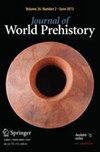Polished Stone Axes in Caput Adriae from the Neolithic to the Copper Age
IF 3.1
1区 历史学
Q1 ANTHROPOLOGY
引用次数: 2
Abstract
This paper reports the results of a long-term project on the stone axes from Caput Adriae. Available data show that jade axes originating in the western Alps reached the Neolithic groups of Friuli Venezia Giulia and coastal Istria as early as the second half of the 6th millennium BC, during the Danilo/Vlaška culture. The exchange of this and other classes of lithic artefacts testifies that in this period this area was fully integrated into long-distance exchange systems that used mainly coastal routes. These systems would have continued in the 5th millennium BC, as indicated by a few oversized jade axe blades and other materials. Far from the coast, jade axes entered central Slovenia, probably reaching sites of the Sava Group of the Lengyel culture in the first half of the 5th millennium BC. In roughly the same period, shaft-hole axes made of Bohemian metabasites (BM) spread over central and southeastern Europe, crossed the Alps and reached Italy. According to different Neolithic traditions, during the 5th millennium BC Europe appears to be divided into a jade-using western area and a central-eastern BM-using one. During the 4th millennium BC, the exchange networks of Caput Adriae are increasingly influenced by the eastern Alpine and Balkan world, where the raw material sources of the main groups of shaft-hole axes are located. The association of the rocks used for axe production and copper ore suggests that the changes in raw material exploitation strategies during the Copper Age were probably related to the development of the first metallurgy.从新石器时代到铜器时代,阿德里亚角的抛光石斧
本文报告了一项长期项目的结果,该项目研究了来自阿德里亚角的石斧。现有数据显示,起源于西阿尔卑斯山的玉器斧,早在公元前6千年的下半叶,即达尼洛/Vlaška文化时期,就已经到达了新石器时代的弗留利、威尼斯和伊斯特拉沿海地区。这种和其他种类的石器制品的交换证明,在这一时期,该地区完全融入了主要使用沿海路线的长途交换系统。从一些超大的玉斧刃和其他材料可以看出,这些系统在公元前5千年还在继续。在远离海岸的地方,玉斧进入了斯洛文尼亚中部,可能到达了公元前5千年上半叶Lengyel文化的Sava群的遗址。大约在同一时期,波希米亚变质岩(BM)制成的轴孔轴遍布欧洲中部和东南部,越过阿尔卑斯山到达意大利。根据不同的新石器时代传统,公元前5千年的欧洲似乎被分为使用玉器的西部地区和使用宝石的中东部地区。公元前4千年,阿德里亚角的交换网络越来越多地受到阿尔卑斯东部和巴尔干世界的影响,那里是轴孔轴主要群体的原材料来源。将用于制斧的岩石与铜矿联系起来,表明铜器时代原材料开采策略的变化可能与第一次冶金术的发展有关。
本文章由计算机程序翻译,如有差异,请以英文原文为准。
求助全文
约1分钟内获得全文
求助全文
来源期刊

Journal of World Prehistory
Multiple-
CiteScore
5.30
自引率
0.00%
发文量
8
期刊介绍:
Aims and scopeJournal of World Prehistory is an international forum for the publication of peer-reviewed, original treatments of the prehistory of an area or larger region. It was founded nearly thirty years ago with the remit of providing researchers, instructors and students with timely and authoritative research syntheses from all fields of archaeology. Journal of World Prehistory continues to lead in this field. Our classic articles may be 20,000 or 25,000 words long, as appropriate (excluding their extensive bibliographies). Since 2008 they have been joined by shorter (around 10,000 words), position pieces, which provide in-depth, thoughtful development of data and concepts, including interventions in controversies that unfold in our pages. These, written in a fashion interesting and accessible to all archaeologists, are often paired with a longer treatment in a single volume. In addition, readers now benefit from thematic special issues and double issues, in which a number of leading authors deal with a key theme in world prehistory, such as the origins of metallurgy (2009, volumes 22: 3 and 4), or the East Asian Neolithic (2013, in preparation). All papers are available first online, followed by the print edition. We aim to be truly global in coverage, with recent articles dealing, inter alia, with Amazonian lithics, the late Jomon of Hokkaido, the Bronze Age in Southeast Asia, the Neanderthal settlement of Doggerland, Neolithic networks in Western Asia, younger Dryas Paleo-Indian adaptations, and state formation in the Horn of Africa. Articles benefit from multi-language abstracts where appropriate, and we work closely with authors who do not have English as a first language to present major syntheses in a clear and concise way to an international audience. Traditionally, JWP focuses on earlier periods, but it includes the beginnings and early development of complex societies, and our understanding of ‘prehistory’ is broad and inclusive: for guidance on chronological scope, as well as our calendrical conventions, see the editorial article ‘Prehistory vs. Archaeology: terms of Engagement’ http://www.springerlink.com/content/346142p032604447/ Our unique remit means that we do not encourage the submission of unsolicited papers; rather, specific proposals are encouraged and then guided prior to independent peer review. Our aims and the way we fulfil them, with close contact with authors throughout the publication process, mean that JWP is not a venue for the simple and rapid dissemination of new results. Whilst we expect scholarship to be current, with syntheses including much new data, our readers look to us for definitive area/period coverage that will have continuing value.If you are proposing an article or special theme for Journal of World Prehistory, please read the Instructions for authors.Rated ''A'' in the European Reference Index for the Humanities (ERIH)?Journal of World Prehistory is rated ''A'' in the ERIH, a new reference index that aims to help evenly access the scientific quality of Humanities research output. For more information visit http://www.esf.org/research-areas/humanities/activities/research-infrastructures.htmlRated ''A'' in the Australian Research Council Humanities and Creative Arts Journal List. For more information, visit: http://www.arc.gov.au/era/journal_list_dev.htm
 求助内容:
求助内容: 应助结果提醒方式:
应助结果提醒方式:


